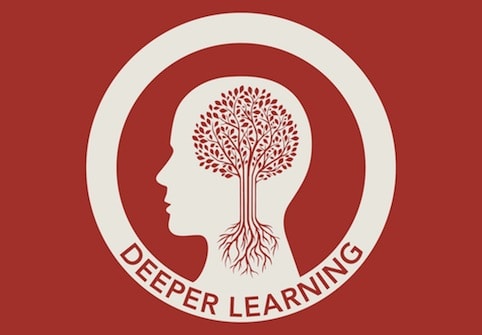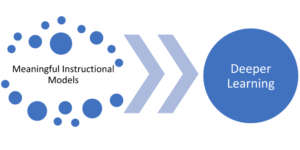Deeper Competency-Based Learning

Underlying the shift to blended and student-centered environments is the transition from marking seat time to tracking learning. In competency-based environments, students show what they know and they progress when they’ve demonstrated mastery.
There are a couple versions of competency-based learning that may result in accelerated progress but not necessarily better preparation. Perhaps you’ve seen one of these examples:
- A credit recovery lab where students fly through flat content, click a few buttons in an end-of-unit multiple choice quiz, and move on to the next unit, or
- A teacher has turned standards into checklist of sub-skills in preparation for a fact-based test.
Both examples are well intentioned but not true examples of deeper learning.CompetencyWorks, a project of iNACOL, stresses the use of ongoing, authentic and integrated assessments to gather information about where students are on their individual learning trajectories in order to guide curriculum and instruction.
We’ve been scouring the country for schools that are not only competency-based but provoke inquiry, critical thinking, production of professional quality work products, and skillful communication. We found a handful of schools that ask the big rather than the small questions. They don’t just ask students to turn in a test, they demand public demonstrations of learning. They don’t just track test scores, they catalog student work. Students don’t fail, they just get more time to learn and improve.
Big questions. According to principal Chris Stinson, Anson New Tech’s project-based learning approach means “students begin by identifying an authentic, genuine issue of importance in the world, and then work to solve it.”
Anson County is east of Charlotte North Carolina. One of the district high schools, it is a member of the New Tech Network, 150 project-based high schools that share thought provoking projects across the Echo platform. New Tech teachers promote critical thinking by building it into the rubrics used to assess student projects.
Revision. Noting a “strong culture of revision,” Envision Education superintendent Gia Truong explained that “students have to defend their work, and they may not pass. They may have to go back and do some things again until they can prove mastery.
Envison Education, a network of three model Bay Area high schools, uses a portfolio system linked to competencies. They “require students to continue to work and revise, work and revise, so they learn to persist and to accept and use feedback.”
Anson students are judged advanced, proficient, or unsatisfactory. The proficient column represents mastery of the state standards and the advanced one represents the ability to apply that knowledge to another situation. Unsatisfactory means the student gets to go back and try again.
Portfolio. David Coleman, CEO of College Board called portfolio “a collection of personal bests.” Portfolios are central to the Expeditionary Learning (EL) model, which focuses on “literacy, reflection, and interdisciplinary, project-based learning.” Because they must be presented publicly to peers, parents, and the larger community, portfolios also operate as evidence of students’ written and oral communications skills.
Sussex Academy , an EL school in Delaware, uses portfolios to document the mastery of state standards, to highlight the EL principles, to chronicle student progress throughout the year, and to assess continuous student performance.
Sussex teachers encourage students to take responsibility for their own learning. Students work with teachers to set their own goals, record their daily expectations and achievements, and maintain their own student data.
Going public. Dee Thomas, director of Minnesota New Country School (MNCS), says their approach is to “ask students what their passion is and weave the state standards into that.” As a result, students outline their own learning goals under the direction of a licensed advisor and then show mastery of core academic content by producing or creating something and then defending what they have learned with a team of licensed teachers.
MNCS, anchor of the Edvisions network, demonstrates that interest-based learning can be integrated into standards-based learning. They track competencies (using ProjectFoundry) but students aren’t accumulating a bunch of abstract knowledge and skills, they are co-constructing a sequence of powerful learning experiences.
Tech-enabled. While technology is not a prerequisite for competency education, learning environments that offer easy and reliable access to blended and online opportunities certainly streamline the assessment and feedback loop for teachers and students.
In Cohorts to Competency, we outlined advances in technology making it possible to bring competency education to scale, thanks to the growing set of tools that can help create and manage customized pathways. “Without leveraging technology and discovering new ways to use time and resources differently, we will fail to achieve the goals of college- and career-ready standards.” Shifting to competency-based education is an important step in the process.”
Competency-based environments and policies can promote deeper learning where teachers ask big question, build a culture of revision, demand public demonstrations of learning, and collect artifacts that represent personal bests. Platforms like New Tech’s Echo hold the potential of bringing powerful practices to scale.
Tom is a director at iNACOL




Jonathan Marks
Good post. It is good to see innovators not throwing the baby (e.g. big questions, attention to revision) out with the bathwater (e.g. one size fits all ed.)
Wondering what you think of NAU's sample competency based transcript, which Paul Fain writes about and links to here:
http://tinyurl.com/klz2gk7
It seems more marketing than substance to me (as if they have taken a few bits and pieces from a course catalog and dubbed them competencies), but you will know better.
Replies
Tom Vander Ark
Thanks Jonathan. I agree with Cliff Adelman, “God bless them for actually trying."
Seems like a reasonable effort, key will be execution. Actual practices/traditions could force most students through traditional courses....we'll see